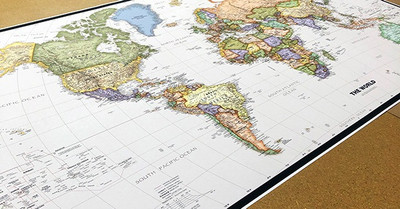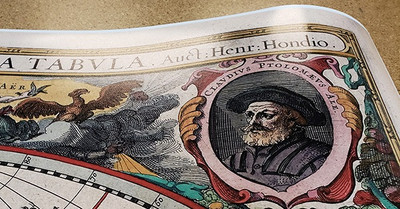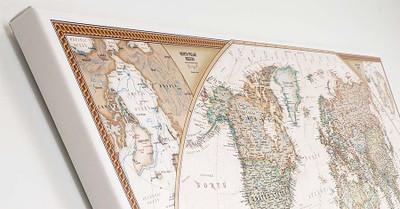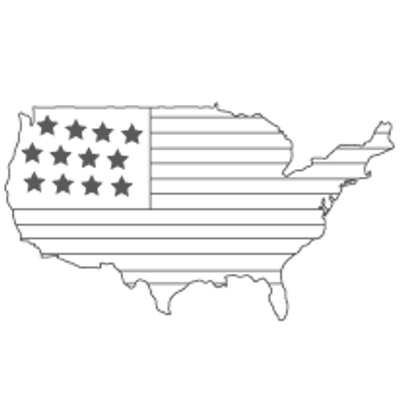
Historical Map of US Proposed Roads & Highways - 1915
Description
National Highways Map of the United States showing principal Transcontinenal Highways and connecting system of One Hundred Thousand Miles of National Highways.
The National Highways Association (NHA) was established in 1911 to promote the development of an improved national road network in the United States. Under the slogan “Good roads for everyone!” the NHA proposed a 150,000-mile (241,402-kilometer) network of roads, based on a four-fold system of national, state, county, and town or township highways and roads.
This map, issued by the NHA in 1915, shows the tentative routes of the most important highways in this network, totaling 100,000 miles (160,934 kilometers) in length. The table at the top provides estimates of the numbers and percentages of people living in counties traversed by the proposed national highways or counties adjoining them. The map associates the cause of good roads with the “preparedness” debate concerning possible U.S. intervention in World War I that was underway at this time. The map also contrasts the purported benefits of the Panama Canal, opened the previous year, with those of the proposed national road system, claiming (on what basis is unclear): “They cost the same.” Besides issuing brochures and circulars aimed at convincing citizens of the need for a national road system, the NHA was a prolific producer of maps.
Cartographic work was done at an office in South Yarmouth, Massachusetts, where approximately 40 people were employed on the property of Charles Henry Davis (1865–1951), president and cofounder of the NHA. Davis believed that these maps would be helpful to a national highways commission that he hoped would be established and that they would assist the states in integrating their roads into a national system. Congress never embraced the plan put forward by the NHA, but the organization and its maps helped to promote the cause of a national road network.
Materials
Archival Paper

Premium fine art paper that provides accurate color reproduction with high-contrast, high-resolution print output and maximum image permanence. A high-quality print ready for framing.
More
- Museum quality paper for high-quality fine art.
- Ultra smooth, neutral white matte finish.
- Heavy-weight 230 gsm, 9.5 mil thickness.
- Printed with pigment inks for longer print life and enhanced fade resistance.
- Pigment based Canon LUCIA inks provide smooth tones and rich colors in fine, precise detail.
Luster Photo Paper

A premium semi-gloss photo paper with a subtle texture that produces a vivid, richly detailed print. This material results in an exquisitely detailed giclee print of substantially higher quality than a standard poster.
More
- Printed on 10 mil premium luster photo paper resulting in a brilliant, colorful image with a vivid life-like quality.
- Pigment based Canon LUCIA inks provide smooth tones and rich colors in fine, precise detail.
- Inks have a lightfastness rating of over 100 years, guaranteeing minimal noticeable fading over a very long period of time.
- Printed using very high resolution source files.
- Giclee printing is superior to traditional lithography in a number of ways: colors are brighter, lasts longer, and is a higher resolution.
Canvas on Wood Rails

A canvas giclee print is mounted to wooden hanging rails placed along the top and bottom of the map. Ready to hang on the wall using the attached hanging cord. Wood rails feature a natural finish.
More
- Premium 19 mil canvas material.
- Wood rails are 1 1/8" wide, round front.
- USA sourced solid maple wood.
- High quality giclee fine art print with a lightfastness rating of over 100 years.
- Pigment based Canon LUCIA inks provide smooth tones and rich colors in fine, precise detail.
Canvas Gallery Wrap

A high quality canvas giclee print is hand stretched over a sturdy wood frame. Printed on demand and handcrafted in Seattle, WA. The canvas gallery wrap serves as a stunning piece of art ready to hang on your wall.
More
- Premium 19 mil canvas material.
- Pigment based Canon LUCIA inks provide smooth tones and rich colors in fine, precise detail.
- High quality giclee fine art print with a lightfastness rating of over 100 years.
- Durable canvas mounted to a 1" deep wood frame.
- Ready to hang with included easy-to-use hanging kit.
Framed Map Print - Black Finish

Our gallery quality frames are made of solid wood and feature optical-grade acrylic. Each framed map is printed on premium archival matte fine art paper.
More
- Printed on thick, luxurious acid-free fine art paper & dry-mounted to foam board.
- Pigment inks ensure a vivid print with amazing colors and excellent fade resistance.
- Solid wood frame with a black finish has a 1.25" face & 7/8" depth.
- Kraft paper protective backing & hanging wire installed.
Framed Map Print - Natural Oak Finish

Our gallery quality frames are made of solid wood and feature optical-grade acrylic. Each framed map is printed on premium archival matte fine art paper.
More
- Printed on thick, luxurious acid-free fine art paper & dry-mounted to foam board.
- Pigment inks ensure a vivid print with amazing colors and excellent fade resistance.
- Solid wood frame with a natural oak finish has a 1.25" face & 7/8" depth.
- Kraft paper protective backing & hanging wire installed.

Made In The USA

School Purchase Orders









